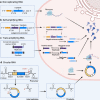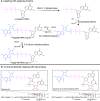Advances in COVID-19 mRNA vaccine development
- PMID: 35322018
- PMCID: PMC8940982
- DOI: 10.1038/s41392-022-00950-y
Advances in COVID-19 mRNA vaccine development
Abstract
To date, the coronavirus disease 2019 (COVID-19) caused by severe acute respiratory syndrome coronavirus 2 (SARS-CoV-2) has determined 399,600,607 cases and 5,757,562 deaths worldwide. COVID-19 is a serious threat to human health globally. The World Health Organization (WHO) has declared COVID-19 pandemic a major public health emergency. Vaccination is the most effective and economical intervention for controlling the spread of epidemics, and consequently saving lives and protecting the health of the population. Various techniques have been employed in the development of COVID-19 vaccines. Among these, the COVID-19 messenger RNA (mRNA) vaccine has been drawing increasing attention owing to its great application prospects and advantages, which include short development cycle, easy industrialization, simple production process, flexibility to respond to new variants, and the capacity to induce better immune response. This review summarizes current knowledge on the structural characteristics, antigen design strategies, delivery systems, industrialization potential, quality control, latest clinical trials and real-world data of COVID-19 mRNA vaccines as well as mRNA technology. Current challenges and future directions in the development of preventive mRNA vaccines for major infectious diseases are also discussed.
© 2022. The Author(s).
Conflict of interest statement
The authors declare no competing interests.
Figures








Similar articles
-
Perspectives and Prospects on mRNA Vaccine Development for COVID-19.Curr Med Chem. 2022;29(23):3991-3996. doi: 10.2174/0929867329666220216110931. Curr Med Chem. 2022. PMID: 35170403
-
COVID-19 mRNA vaccines: Platforms and current developments.Mol Ther. 2022 May 4;30(5):1850-1868. doi: 10.1016/j.ymthe.2022.02.016. Epub 2022 Feb 19. Mol Ther. 2022. PMID: 35189345 Free PMC article. Review.
-
mRNA vaccines for COVID-19: what, why and how.Int J Biol Sci. 2021 Apr 10;17(6):1446-1460. doi: 10.7150/ijbs.59233. eCollection 2021. Int J Biol Sci. 2021. PMID: 33907508 Free PMC article. Review.
-
mRNA Vaccines: Design Principles, Mechanisms, and Manufacturing-Insights From COVID-19 as a Model for Combating Infectious Diseases.Biotechnol J. 2025 Feb;20(2):e202400596. doi: 10.1002/biot.202400596. Biotechnol J. 2025. PMID: 39989260 Review.
-
The Rapid Development and Early Success of Covid 19 Vaccines Have Raised Hopes for Accelerating the Cancer Treatment Mechanism.Arch Razi Inst. 2021 Mar;76(1):1-6. doi: 10.22092/ari.2021.353761.1612. Epub 2021 Mar 1. Arch Razi Inst. 2021. PMID: 33818952 Free PMC article.
Cited by
-
Low-sugar universal mRNA vaccine against coronavirus variants with deletion of glycosites in the S2 or stem of SARS-CoV-2 spike messenger RNA (mRNA).Proc Natl Acad Sci U S A. 2023 Dec 5;120(49):e2314392120. doi: 10.1073/pnas.2314392120. Epub 2023 Nov 27. Proc Natl Acad Sci U S A. 2023. PMID: 38011546 Free PMC article.
-
The impact of risk perception and institutional trust on COVID-19 vaccine hesitancy in China.Hum Vaccin Immunother. 2024 Dec 31;20(1):2301793. doi: 10.1080/21645515.2024.2301793. Epub 2024 Jan 28. Hum Vaccin Immunother. 2024. PMID: 38282324 Free PMC article.
-
Plasma EV-miRNAs as Potential Biomarkers of COVID-19 Vaccine Immune Response in Cancer Patients.Vaccines (Basel). 2024 Jul 28;12(8):848. doi: 10.3390/vaccines12080848. Vaccines (Basel). 2024. PMID: 39203974 Free PMC article.
-
Exosome for mRNA delivery: strategies and therapeutic applications.J Nanobiotechnology. 2024 Jul 4;22(1):395. doi: 10.1186/s12951-024-02634-x. J Nanobiotechnology. 2024. PMID: 38965553 Free PMC article. Review.
-
Chemistry, structure and function of approved oligonucleotide therapeutics.Nucleic Acids Res. 2023 Apr 11;51(6):2529-2573. doi: 10.1093/nar/gkad067. Nucleic Acids Res. 2023. PMID: 36881759 Free PMC article. Review.
References
-
- Zhang J-j, et al. Clinical characteristics of 140 patients infected with SARS-CoV-2 in Wuhan, China. ALLERGY. 2020;75:1730–1741. - PubMed
Publication types
MeSH terms
Substances
LinkOut - more resources
Full Text Sources
Other Literature Sources
Medical
Miscellaneous

